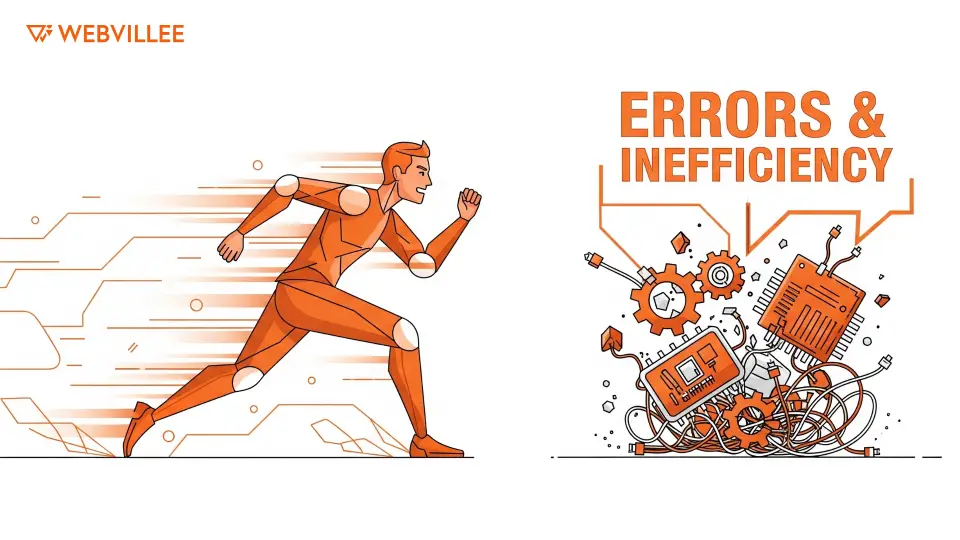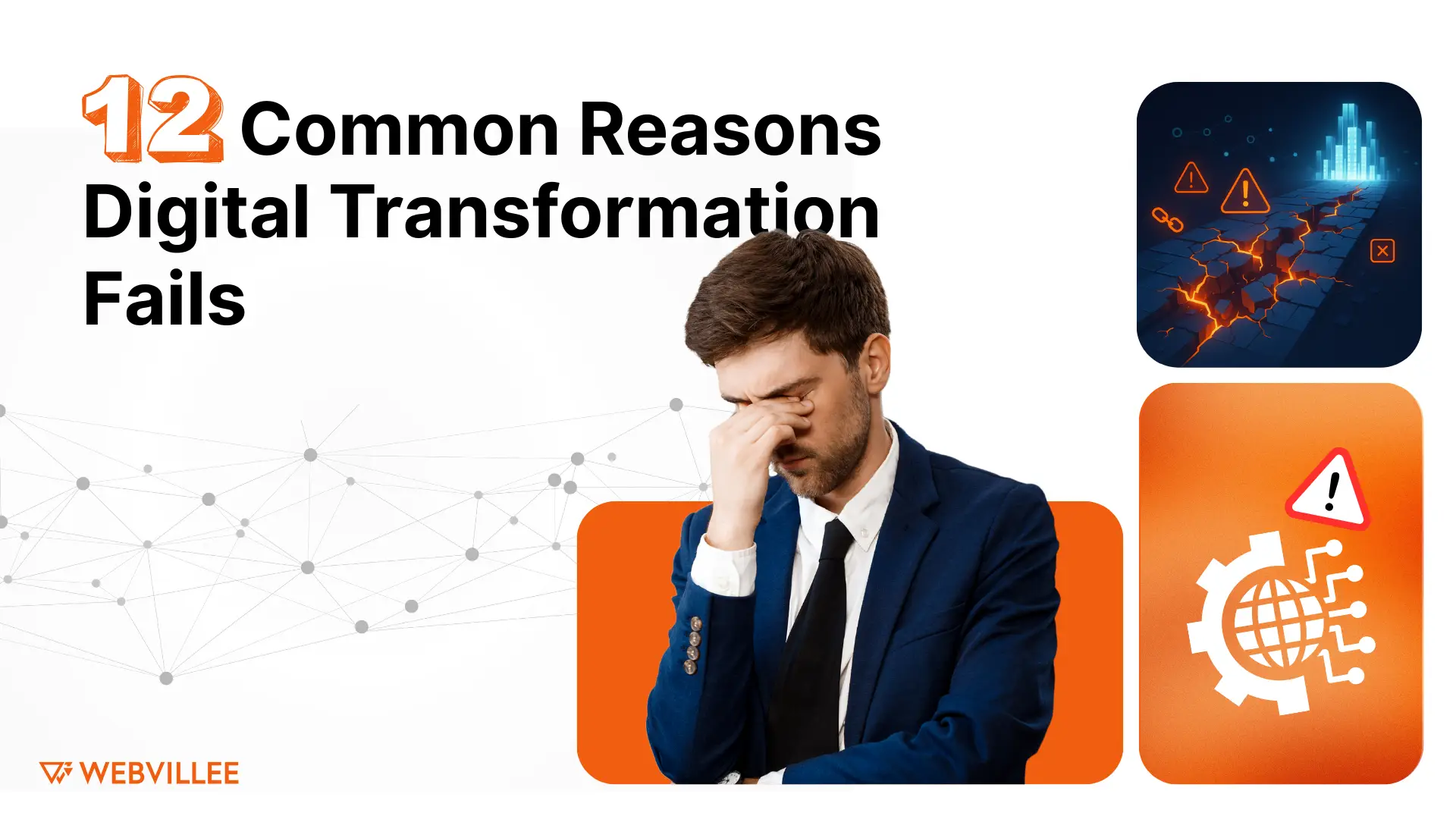Digital transformation initiatives fail because they lack clear goals, leadership support, integration, and user adoption.
Despite heavy investments, many businesses struggle to see results from their transformation projects. Instead of driving efficiency, these projects often create confusion, resistance, and higher costs. This happens when companies treat digital change as only a technology upgrade instead of a business-wide strategy.
Common digital transformation mistakes include poor planning, failed transformation projects that do not align with strategy, and ignoring user needs. Without a structured approach, companies end up with fragmented systems and wasted budgets.
Leaders must understand why so many initiatives fail in order to avoid repeating the same errors. By learning from these failures, organizations can design strategies that deliver measurable impact and long-term value. This blog explores twelve reasons why projects collapse and what business leaders can do differently to ensure transformation succeeds.
Why does unclear vision lead to failure?
Unclear vision leads to failure because projects drift without defined digital transformation goals.
Every transformation needs a clear purpose. When leadership cannot explain what success looks like, teams lose direction and focus. This often results in wasted resources and outcomes that do not solve the real problem.
Key reasons lack of vision in transformation creates failure:
- Goals are not tied to measurable outcomes.
- Teams work in silos without alignment.
- Leaders fail to communicate priorities across the business.
For example, if a company launches a transformation to “improve efficiency” without defining how, employees may choose conflicting paths. Some may digitize documents, while others redesign workflows. Without clarity, progress cannot be measured, and the initiative eventually loses momentum.
When connected to Digital Transformation strategy, clear goals create alignment. Business leaders can link investments directly to outcomes such as reduced operating costs, faster decision making, or improved compliance.
In 2025, successful transformations begin by asking: What business problem are we solving? Clear vision ensures teams focus on results rather than technology for its own sake.

Why does weak leadership derail transformation?
Weak leadership derails transformation because projects need strong sponsors to guide them to success.
Digital transformation is not just a technical change, it requires cultural and strategic shifts. Leaders must actively champion the initiative, provide resources, and make tough decisions when challenges arise. Without this involvement, projects lose credibility.
Signs of leadership failure in transformation include:
- Executives treating transformation as a side project.
- Lack of communication about vision and goals.
- Inconsistent decision making across departments.
When leaders step back, employees assume transformation is optional. This leads to resistance, poor adoption, and fragmented efforts. On the other hand, when leaders model commitment, teams follow their lead.
Strong leaders also build accountability. They set performance expectations, assign responsibilities, and measure progress. Without this guidance, transformation projects lack urgency and often stall.
In short, leadership is the fuel that drives transformation forward. When leaders fail to engage, projects inevitably fail.
How does resistance to change cause problems?
Resistance to change causes problems because employees push back when change management is ignored.
People are often comfortable with existing systems. When new processes are introduced without support, fear and frustration take over. This slows adoption and undermines transformation goals.
Common causes of employee resistance to transformation:
- Lack of communication about why changes are happening.
- Insufficient involvement of employees in planning.
- Concerns about job security or workload increases.
When businesses overlook change management, even the best technology fails. Employees may ignore new systems or create workarounds that weaken efficiency.
By linking change management with Managed IT Services, companies can provide consistent support during transitions. IT teams can train staff, answer questions, and resolve technical issues quickly. This builds trust and reduces pushback.
Successful transformations treat employees as partners, not obstacles. Clear communication, training, and ongoing support make adoption easier and prevent resistance from stalling progress.
Why does poor user adoption sink initiatives?
Poor user adoption sinks initiatives because systems fail if employees do not embrace the new tools.
Even the most advanced technology cannot deliver results unless people use it effectively. Without user adoption, businesses face wasted investments and missed opportunities for improvement.
Factors behind poor user adoption in transformation:
- Inadequate training and lack of ongoing support.
- Complex system designs that frustrate employees.
- Lack of visible benefits for users in their daily tasks.
For example, if a new ERP system is introduced without proper guidance, employees may continue relying on spreadsheets. This prevents the system from achieving its intended efficiency.
To improve adoption, leaders must invest in training, simplify user experiences, and create feedback loops that allow continuous improvement. When employees see how tools help them succeed, adoption follows naturally.
In 2025, transformation success is measured not just by system launch but by how fully employees use and trust the system.
How does lack of integration create silos?
Lack of integration creates silos because disconnected business systems prevent efficiency and collaboration.
Digital transformation requires seamless data flow across departments. When tools are not integrated, each department operates with its own version of the truth, slowing decision making and creating errors.
Examples of integration failure in transformation:
- CRM not connected to ERP, leading to inconsistent sales and finance data.
- Supply chain tools not integrated with inventory systems.
- Customer service platforms isolated from product and operations data.
These silos result in duplicated efforts and missed opportunities. For instance, sales teams may promise delivery timelines that operations cannot meet due to lack of shared data.
By leveraging CRM & ERP integration, companies can unify systems into a single platform that supports accurate and real time decision making. Integration ensures consistency, reduces duplication, and improves customer experiences.
In 2025, successful transformation means breaking down silos and building a unified digital ecosystem.

Why is ignoring compliance and governance a mistake?
Ignoring compliance and governance is a mistake because projects fail if regulatory requirements are not addressed.
Businesses today operate under strict data privacy and reporting rules. When compliance is overlooked, organizations face fines, reputational damage, and costly project rework.
Common compliance and governance failures include:
- Weak data protection measures.
- Lack of audit trails for reporting.
- Ignoring industry-specific regulations during system design.
For example, a healthcare provider that fails to safeguard patient records risks violating data laws. A financial institution that cannot generate accurate audit reports may lose investor trust.
Modern platforms help by embedding governance tools into transformation processes. Paired with Cloud Solution capabilities, businesses can maintain secure systems while ensuring compliance at scale.
In 2025, compliance is not optional. Digital transformation must be built on governance to protect data, maintain trust, and support long-term business sustainability.
How does insufficient training hurt outcomes?
Insufficient training hurts outcomes because users without proper knowledge cannot leverage new systems.
When training is ignored, employees rely on old processes or misuse new tools. This not only reduces efficiency but also increases errors and frustration.
Training gaps that cause transformation failure include:
- Limited role-specific training sessions.
- Lack of ongoing support after system launch.
- Absence of user-friendly documentation or resources.
For example, finance teams may fail to use reporting dashboards correctly if they only receive generic training. As a result, valuable insights are lost, and decision making suffers.
Effective training builds confidence and trust in the system. It also encourages employees to explore features that improve productivity. Without it, transformation initiatives quickly lose momentum.
In 2025, user training is not a side activity but a core investment that ensures successful outcomes. Businesses must prioritize continuous learning to maximize results.
Why does underestimating costs cause projects to stall?
Underestimating costs causes projects to stall because hidden expenses quickly overwhelm budgets.
Transformation projects involve more than software licenses. They require investments in infrastructure, training, integration, and ongoing support. Failure to anticipate these costs often leads to stalled projects.
Examples of hidden transformation costs:
- Additional customization requirements.
- Extended timelines due to unforeseen complexity.
- Higher resource costs for specialized talent.
When budgets collapse, leadership loses confidence, and projects are paused or canceled. This not only wastes money but also erodes trust in future initiatives.
By linking with Product Engineering services, businesses can plan more accurately. Engineering teams help identify potential risks and create realistic cost estimates before implementation.
In 2025, financial planning is as critical as technical planning. Companies that prepare for hidden costs are the ones that complete their digital transformation successfully.
How does rushing implementation lead to setbacks?
Rushing implementation leads to setbacks because speed without planning creates errors and inefficiency.
Organizations eager to show quick results often skip critical steps like testing, training, and stakeholder alignment. This creates technical problems and poor user experiences.
Risks of rushing transformation projects include:
- Unstable systems with frequent errors.
- Users unprepared to adopt new processes.
- Misalignment between system features and business needs.
For example, a retail company that launches a new e-commerce system too quickly may face outages during peak demand. This damages customer trust and reduces sales.
Successful projects balance urgency with discipline. Phased rollouts, pilot programs, and thorough testing ensure smoother adoption. While speed is valuable, skipping steps leads to greater delays in the long run.
In 2025, leaders must recognize that careful execution delivers better outcomes than rushed deployments.

Why does lack of measurable KPIs matter?
Lack of measurable KPIs matters because without metrics leaders cannot track or prove success.
Digital transformation is complex, and progress must be measured through clear indicators. Without KPIs, teams cannot identify whether investments are delivering the desired value.
Examples of missing KPIs in transformation projects:
- No benchmarks for cost savings.
- Lack of metrics for employee adoption.
- No performance indicators for customer satisfaction.
When KPIs are absent, leaders cannot justify spending or adjust strategies. This often leads to stalled projects or skepticism about transformation value.
By connecting projects with Service Now metrics, businesses can monitor workflows, measure efficiency, and track adoption in real time. KPIs provide the evidence needed to refine strategies and secure ongoing support.
In 2025, transformation is only as strong as the data that proves its success. Without KPIs, even well-designed projects risk being abandoned.
How does ignoring scalability limit success?
Ignoring scalability limits success because systems that cannot grow with the business eventually fail.
Digital transformation is not a one-time project. As businesses expand, systems must handle higher volumes of data, more users, and greater complexity. Without scalability, companies are forced into costly upgrades or replacements.
Consequences of scalability failure in transformation:
- Systems that crash under increased demand.
- Processes that cannot adapt to global expansion.
- Higher costs for frequent system replacements.
For example, a logistics company that deploys software without scalability may struggle when entering new markets. This results in operational bottlenecks and lost opportunities.
By adopting Simplified IoT Solutions, businesses can design systems that scale efficiently while maintaining performance. Scalable platforms provide flexibility for growth and reduce long-term costs.
In 2025, scalability is essential. Transformation initiatives must be built for the future, not just for immediate needs.
Why is failing to align with business strategy the biggest risk?
Failing to align with business strategy is the biggest risk because technology only works when it supports long-term goals.
Many projects fail because they focus on adopting new tools without connecting them to business objectives. This creates systems that operate in isolation and do not contribute to overall success.
Examples of misaligned transformation strategy:
- Investing in tools that do not solve critical business challenges.
- Prioritizing technology upgrades without considering customer impact.
- Overlooking industry-specific requirements in transformation planning.
When transformation does not align with business needs, adoption suffers and leaders lose trust in the project.
By leveraging SAP Services, companies can design transformation initiatives that are directly linked to strategy. This ensures technology choices reflect industry requirements, compliance needs, and growth priorities.
In 2025, alignment is the difference between failure and success. Transformation projects must serve the business, not just the technology roadmap.
What can businesses learn from failed transformations?
Businesses can learn that most digital transformation initiatives fail due to preventable mistakes like unclear goals, poor adoption, and lack of alignment.
Success depends on strategy, leadership, and continuous measurement. When organizations plan carefully, train employees, and build scalable systems, transformation becomes a growth driver instead of a burden.
These twelve reasons highlight the importance of discipline in execution. Companies that avoid rushing, plan for costs, and integrate systems effectively stand a better chance of long-term success.
For decision makers, the key takeaway is that transformation is a journey, not a one-time project. Learning from past failures ensures that future initiatives deliver measurable results and sustainable business value.
Get in touch with Webvillee to design digital transformation strategies that succeed.

